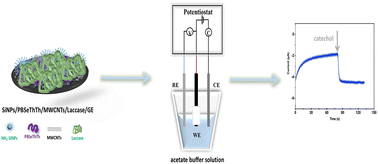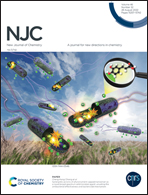Fabrication of D–A–D type conducting polymer, carbon nanotubes and silica nanoparticle-based laccase biosensor for catechol detection
Abstract
Herein, the biosensor design incorporates triple key materials based on amino-functionalized silica nanoparticles (SiNPs), both thieno[3,2-b]thiophene and 2,1,3-benzoselenadiazole groups containing a D–A–D type conducting polymer, and multiwalled carbon nanotubes (MWCNTs). First, the D–A–D type conducting polymer (PBSeThTh) containing thieno[3,2-b]thiophene and 2,1,3-benzoselenadiazole groups was synthesized and characterized in detail. Second, the biosensor surface was modified by adding SiNPs, PBeSeThTh, and MWCNTs on the graphite rod electrode surface. Finally, the electrochemical transducer of this trio was integrated with laccase enzyme, resulting in a highly sensitive biosensor for the detection of catechol in water samples. Unlike biosensors that integrate a unique nanomaterial-based layer without PBSeThTh, the SiNPs/PBSeThTh/MWCNTs-based new tool allowed promising sensor characteristics. The electrochemical and morphological biosensor surface characteristics were investigated using cyclic voltammetry (CV) and scanning electron microscopy (SEM)/atomic force microscopy (AFM) techniques, respectively. Moreover, the biosensor was used for the rapid detection of low concentrations of catechol in tap water samples and exhibited satisfactory reproducibility and accuracy.



 Please wait while we load your content...
Please wait while we load your content...